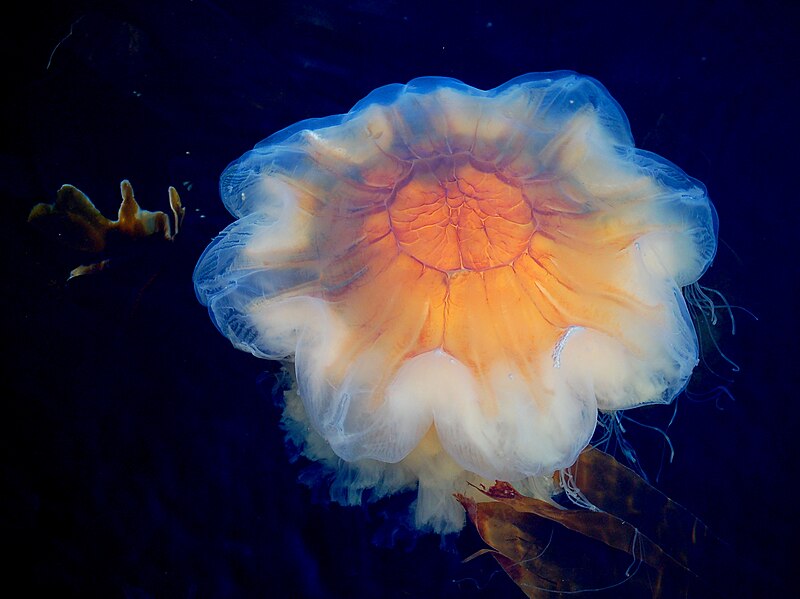Most animals covered in this series have at least one or two traits that appear human-like, either in appearance or in behaviour, for example most eyes are circular, many animals also have hands and feet or at the very least legs, then there are anthropomorphological observations such as the sadness observed in an animals’ eyes.
The Jellyfish on the other hand does not possess a single trait that resembles any part of our anatomy or behaviour, though some people do just drift along in life, so I guess you could say there are behavioural similarities!
They appear Alien, mysterious in a sense of trying to pinpoint how their evolutionary timeline resulted in the animals we see today, their simplistic design and nomadic lifestyle serves very little purpose other than to feed or breed, but by delving in to their anatomy we can actually see there is a high degree of complexity in their simplicity.
The Lions-mane Jellyfish seems like the perfect animal to cover as an introduction to the fascinating phylum of Cnidaria.
Description and Distribution
The Lions-mane Jellyfish (Cyanea capillata) is the largest species of Jellyfish currently known to science, their size seems to be determined by the temperature of the water as the average Lions-mane varies dramatically in size throughout its range.
In the colder northern waters, they can achieve a bell diameter exceeding 2 metres meaning the average Human could lay comfortably across the top of them, the further south they are the smaller they become, with the smallest mature individuals reaching a bell diameter of just 0.5 metres.
This difference in size also commonly leads to a difference in colouration, the larger northern specimens are frequently a deep red or purple colour, whereas those observed in lower latitudes are frequently a light orange or tan colour, this difference may be a result of a variation in diet though this has yet to be tested and remains just a theory.
From the limited studies that have been conducted there is no indication that spawning between larger and smaller or different coloured individuals has any effect on the viability of the offspring produced, as such it is unlikely that the Lions-mane Jellyfish well ever be separated in to several sub-species based on geographic range and appearance.
Their name derives from the appearance of their trailing tentacles which form a thick mesh of strands resembling that of a Lions-mane, it is often dark in appearance as the tentacles are tightly packed to a point that they lose the translucent effect that is noticeable on the bell.

Image credit:Wikimedia Commons There is a debate as to whether the Blue Jellyfish found throughout the southern hemisphere is the same species
If you thought that their bell diameter was large, the sheer size of their tentacles dwarves it in comparison, larger than average individuals can possess tentacles that stretch for over 30 metres, the largest Lions-mane Jellyfish ever observed had tentacles that were 37 metres (120 foot for our imperial friends) long, making it comfortably longer than the largest animal that’s ever existed, the Blue Whale.
The Lions-mane Jellyfish is a cold-water species and cannot be found at temperate latitudes, they are present throughout the north-Atlantic and north-Pacific and are also frequent in the English Channel, North Sea and the Arctic ocean.
It’s debatable whether a similar species found in the waters surrounding Australia, New Zealand and Argentina could in fact be the same species, currently they are separated at the species level under the genus Cyanea, though some Zoologists believe them to be the same species that should instead be denoted as varying subspecies.
The Brain of the Jellyfish
The general anatomy of the Lions-mane Jellyfish does not differ to much from the simple anatomy of other Jellyfish species, as in they possess tentacles, arms, a bell, a mouth, Gonads, a digestive system, and sensory nodes, they do not possess a brain.
It’s difficult to imagine life without a brain, well you wouldn’t be able to imagine for a start, though the Jellyfish proves that it is not a requirement for multi-cellular life, they are perfectly adapted to live their life autonomously.
Whilst the Jellyfish does not possess a brain, they do possess a “nerve-net” located in the Epidermis which connects to nerve endings at the base of their tentacles, this effectively functions as a primitive central nervous system, but if they aren’t connected to a central brain, what processes the information they gather, and can they react to stimuli?

Image credit: Wikimedia Commons Anatomical diagram of a typical Jellyfish, the Lions-mane does not possess some of the features in the diagram such as the Velum
To answer the first question, nothing, the nerve endings are able to detect changes in salinity (density of seawater), temperature and are also able to detect touch, such information triggers an involuntary reflex response, comparatively they respond in the same manner as a basic if statement.
As an example, if the nerve endings detect no touch they will supply a false statement which will prevent their stinging cells from engaging, if they detect touch they will supply a true statement and the stinging cells will fire instantaneously, a relatable response in Humans would be a standard reflex test, both responses are involuntary.
The entire processing capabilities of the Jellyfish are present in their nerve endings which are connected to various anatomical features, so to answer the second part of the question, yes, they can respond to stimuli, but only via an involuntary response, furthermore they will not nurse damaged areas / wounds and though they cannot feel pain they will exhibit different behaviors when confronted by a predator.
The Stinging Trail
The trailing section behind the bell consists of tentacles and oral arms which are used to move food towards the mouth to be digested, the oral arms are considerably thicker and do not contain any stinging cells which are known as Cnidocytes, Cnidocytes are confined to the tentacles and act as the Jellyfishes main form of defence and offence.
The Cnidocyte cells are essentially ball like structures with a wound-up hypodermic needle within them known as a nematocyst, instead of being rigid like your typical hypodermic needle it is instead malleable and does not straighten until fired.
When the Jellyfish comes in to contact with an object the Nematocyst is triggered, and it straightens out with the aim of injecting into whatever it touched, once injected the Nematocyst then expends a toxic venom shortly after ejection that normally functions as a Neurotoxin.
In the case of the Box Jellyfish its toxin penetrates red blood cells and can induce Heart failure in as few as five minutes in a fully grown adult Human, the Lions-mane has a far less potent toxin and is rarely fatal in Humans though can cause significant discomfort, it’s advisable to avoid touching any Jellyfish as they all possess Cnidocyte cells.
https://youtu.be/6zJiBc_N1Zk
Video credit: Ninjasquid Microscopic video footage of the nematocysts being triggered





